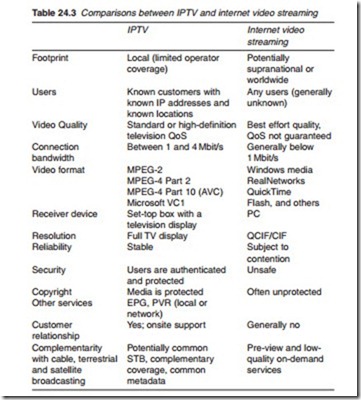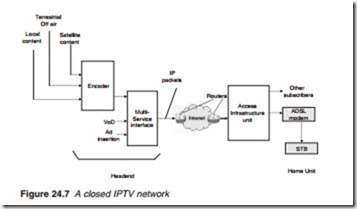Closed IPTV network
A block diagram of the essential elements of a closed IPTV network is shown in Figure 24.7. It consists of four parts:
● Video head-end
● Packet core, transport and network edge
● Access network
● Home network
Content arrives from a satellite or antenna in digital or analogue format, with standard or high definition (or music), encrypted or unencrypted. Once the signal is ‘down-linked’ or ‘down-converted,’ it may need to be altered. Most digital signals use MPEG-2 encoding and transcoding to MPEG-4 or Microsoft’s VC1 is now available to reduce the required bandwidth by up to 50%. Encoding methods intrinsically produce vari- able bit rates (VBR), in which fast-motion requires more bandwidth. With bandwidth at a premium, the operator usually limits the bandwidth that a channel can consume and converts the signal into a constant bit rate (CBR) packet stream. Cross-conversion may be used to change the resolu- tion of the displayed picture. For example, a signal received in 1080i (res- olution of 1920 X 1080) format may be converted to 720p (resolution of 1280 X 720) or into a mobile-friendly format before distribution. For ana- logue signals, an encoder digitises, compresses and packetises the signal.
At the stage, high value content is encrypted so that it may be viewed by paying customers only. Encryption also protects against piracy.
The video and audio content from the various sources described above is fed into the multi-service interface where it is IP encapsulated before going into the internet routing and delivery network. The network must have capacity and QoS reliability to transport massive amounts of simultaneous video traffic from the video headend to central exchange from where it is fed to the subscriber via the Access Infrastructure Unit. The Access Unit is usually the bottleneck in terms of capacity to deliver a reasonable video service. The benchmark for IPTV service delivery over Broadband is
20 Mbps per home based on providing two SDTV, one HDTV, voice, high- speed data and gaming. In addition, the access network must evolve to include features such a TV channel change and multicasting.
As was mentioned earlier, DSL is distance-sensitive. Whilst a TV channel can now be delivered over 2 Mbps most people consider that 20 Mbps down- stream is a requirement for offering an array of Video services to the home.
Fibre to the home with passive optical networks (PON) technology is used to deliver service using end-to-end fibre. Equally effective is Optical Ethernet used for point-to-point connection to customers.

